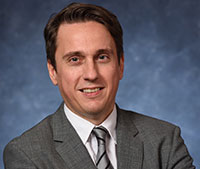Series to Highlight Young Professionals in Signal Processing: Dr. Ervin Sejdić

 This issue brings to you our interview with Dr. Ervin Sejdić, an Associate Professor at the Swanson School of Engineering, University of Pittsburgh, where he directs a research laboratory focused on engineering developments in medicine. His research has focused on creating computational biomarkers indicative of age- and disease-related changes in functional outcomes such as swallowing, gait, and handwriting. Dr. Sejdić has received several prestigious awards including the Presidential Early Career Award for Scientists and Engineers in 2013. He plays several roles in the IEEE Signal Processing Society such as the Newsletter Editor and Young Professionals Committee. Dr. Sejdić is the Editor-in-Cheif of the BioMedical Engineering Online and an Associate Editor of the IEEE Transactions on Biomedical Engineering.
This issue brings to you our interview with Dr. Ervin Sejdić, an Associate Professor at the Swanson School of Engineering, University of Pittsburgh, where he directs a research laboratory focused on engineering developments in medicine. His research has focused on creating computational biomarkers indicative of age- and disease-related changes in functional outcomes such as swallowing, gait, and handwriting. Dr. Sejdić has received several prestigious awards including the Presidential Early Career Award for Scientists and Engineers in 2013. He plays several roles in the IEEE Signal Processing Society such as the Newsletter Editor and Young Professionals Committee. Dr. Sejdić is the Editor-in-Cheif of the BioMedical Engineering Online and an Associate Editor of the IEEE Transactions on Biomedical Engineering.
We approached Dr. Sejdić with a few questions:
Q. Please provide a brief background about yourself.
I’m a classically trained electrical engineer, and during my undergraduate studies, I specialized in wireless communications. During my graduate school, I focused on signal processing, specifically, on time-frequency representations and pattern recognition. My postdoctoral fellowship was more focused on biomedical phenomena. My first postdoc focused on assessing human functions such as swallowing and gait, while my second postdoc focused on comprehensive physiological assessments of older adults with various neurological disorders. In 2011, I joined the University of Pittsburgh as a faculty member, where
I currently lead a research lab devoted to the development of computational biomarkers indicative of age- and disease-related changes and their contributions to functional decline under normal and pathological conditions. In particular, I am proud to say that our mission is to develop clinically relevant solutions by fostering innovation in computational approaches and instrumentation that can be translated into bedside care. My students and I work very closely with patients and clinicians. Almost of all of my students are involved in human subjects research, and they actively recruit subjects for our studies, while also collecting data from these subjects.
Q. How does your work affect society?
In our projects, we attempt to understand and assess two major human functions: swallowing and gait.
Specifically, patients with dysphagia (swallowing disorders) because of stroke, head and neck cancer treatment, and other conditions develop adverse events like aspiration pneumonia, malnutrition, and dehydration at an alarming rate. Dysphagia is prevalent in nursing homes, residential group homes for disabled adults, and in pediatric hospitals. Choking due to airway obstruction and pneumonia due to aspiration (inhalation of swallowed food and liquids) are common results of dysphagia. When recognized in a timely manner before patients are offered oral food, liquids, or medications, these consequences of dysphagia are preventable, but in many settings, they are not identified before these adverse events occur. We typically screen for dysphagia by observing patients drink water or other material. These tests are inexpensive and noninvasive, but the critical barrier is that they cannot identify at-risk patients who aspirate without symptoms (silent aspiration) because silent aspiration is completely invisible to any observer without sophisticated imaging equipment. To address this issue, our major hypothesis is that the analysis of swallowing vibration signals and swallowing sounds may be helpful for identifying both impaired swallowing safety and impaired swallowing efficiency during swallowing screening.
When it comes to a human gait, a loss of motor skill of walking in older adults leads to walking difficulty associated with declines in physical function, morbidity, and mortality. Current standard exercise interventions to prevent or reduce walking difficulty have resulted in only modest improvements in walking that may not be sustainable, particularly in older adults with chronic conditions. The scarcity of clinical measures responsive to changes in the motor skills underpinning walking limit the widespread adoption of these promising approaches. Simple gait metrics (e.g., gait speed, step length, width) have been the primary outcome of clinical trials to improve walking. The motor skills behind walking or the fluency, efficiency, and automaticity of gait that results from the integration of the timing and coordination of stepping with upright posture cannot be represented by simple gait metrics alone. The critical need is to determine gait measures that can distinguish and describe the motor skills associated with the walking process and are most responsive to intervention-related change.
Q. How is your work related to signal processing?
Signal processing is the core of our research. Without signal processing, we would not be able to assess these human functions, and essentially, we would rely on statistical approaches, which are sufficient to describe cohort studies, but not time changes in these functions.
Q. How has your involvement with the IEEE SPS helped you in building your career?
IEEE is essentially the reason why I am doing what I am doing. Back in the late 1990s, I registered as a student member of IEEE. A year or two later, I also joined the signal processing society. I remember reading all editions of the IEEE Spectrum and being in awe of technical developments described by the magazine. I kept imagining what it would be like to be an inventor of some of these cool technical ideas. Somehow I ended up reading about the application of signal processing in medical/clinical fields, and I developed an early desire to contribute to biomedical signal processing. While during my Ph.D. I briefly investigated the application of signal processing in cardiology, I fully immersed myself in the medical field during my postdoc, and I have never looked back. I truly enjoy this work, as I’m still a signal processing engineer, looking for novel solutions, but their application comes from helping other human beings.
Q. Anything else that you would like to add?
Becoming an expert takes years. There is no shortcut. However, IEEE and IEEE SPS can provide a major boost to your careers through various networking opportunities and conferences. Please participate in them! You won’t regret it.

